Another spotless giraffe recorded — this one, in the wild

Just weeks after a Tennessee zoo said it welcomed a rare spotless giraffe, another one has been photographed in the wild – this time in Namibia, Africa. The Giraffe Conservation Foundation announced in a news release Monday the spotless Angolan giraffe was seen on a private game reserve – and it is the first one ever recorded in the wild in Africa.
Brights Zoo in Limestone, Tennessee, made headlines last month when it announced a phenomenal giraffe without any markings was born. That giraffe, eventually named Kipepee, which means "unique" in Swahili, is believed to be the only solid-colored reticulated without spots.

Reticulated giraffes are a species commonly found in northern and northeastern Kenya as well as parts of Somalia and Ethiopia, according to the foundation.
Angolan giraffes, like the one seen in Namibia, live in the desert areas of that country, the foundation says. The spotless giraffe was seen at Mount Etjo Safari Lodge in central Namibia and photographed with its parent.
About 16,000 reticulated giraffes exist in the wild and in 2018 were listed as endangered by the International Union for Conservation of Nature. Their population has decreased by about 50% over the last three decades.
About 10,173 mature Angolan giraffes exist, according to a IUCN study published in 2020. Their population, however, has increased over the last three decades and the IUCN says this species has the "least concern."

Still, the foundation says giraffes have gone extinct in at least seven African countries and there are only 117,000 left on the continent. That means there is one giraffe for every four elephants in Africa.
There are four giraffe species with different spot patterns and the spotlessness seen in the baby Angolan is likely caused by genetic mutations or a recessive genotype that creates their typical patterns, said to Dr. Julian Fennessy, cofounder and director of conservation at the foundation.
"Maybe we do not always need to have explanations for everything. Why don't we simply marvel, about the wonders of nature," Stephanie Fennessy, the foundation's director and cofounder, said in the news release. "Giraffe are in trouble and if we don't act now, our grandchildren might not be able to see any giraffe in the wild when they grow up. That is what really worries me!"
Before Kipekee and the spotless giraffe in Namibia, there had only been one other recording of a spotless giraffe. A giraffe named Toshiko, was born at Ueno Zoo in 1972, according to archival photos.
DeSantis: Founding Fathers would "probably" put age limits on elected officials if they could
Hunter Biden at center of GOP's planned impeachment inquiry into President Biden
Apple unveils iPhone 15, features USB-C charging and periscope lens

